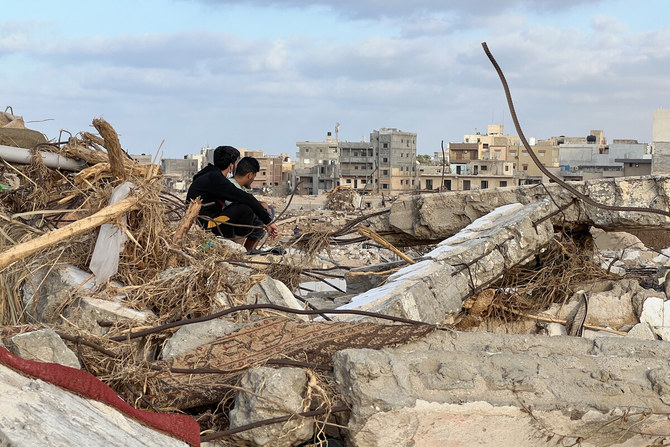
- ARAB NEWS
- 04 Jul 2025

Derna: Libya’s flood disaster, which killed thousands in the city of Derna, also displaced more than 43,000 people, the International Organization for Migration said Thursday.
A tsunami-sized flash flood broke through two aging river dams upstream from the coastal city after the Mediterranean Storm Daniel lashed the area on September 10.
It razed entire neighborhoods, sweeping untold thousands of people into the sea.
The official death toll stands at more than 3,300 — but the eventual count is expected to be far higher, with international aid groups giving estimates of up to 10,000 people missing.
“An estimated 43,059 individuals have been displaced by the floods in northeastern Libya,” the IOM said, adding that a “lack of water supply is reportedly driving many displaced out of Derna” to other areas.
“Urgent needs include food, drinking water and mental health and psychosocial support,” it said.
Mobile and Internet services were meanwhile restored after a two-day disruption, following protests Monday that saw angry residents blame the authorities for the high death toll.
Authorities had blamed the communications outage on “a rupture in the optical fiber” link to Derna, but some Internet users and analysts charged there had been a deliberate “blackout.”
Tripoli-based Prime Minister Abdulhamid Dbeibah announced that communications had been restored in the east, in a post on X, formerly Twitter, on Thursday.
War-scarred Libya remains split between Dbeibah’s UN-backed and nominally interim government in the west, and another in the disaster-hit east backed by military strongman Khalifa Haftar.
The dams that were overwhelmed by the torrential rains of September 10 had developed cracks as far back as the 1990s, Libya’s top prosecutor has said, as residents accused authorities of negligence.
Much of Libya’s infrastructure has fallen into disrepair in the chaos since a 2011 NATO-backed uprising toppled and killed dictator Muammar Qaddafi.
Haftar’s forces seized Derna in 2018, then a stronghold of radical Islamists, and with the reputation as a protest stronghold since Qaddafi’s days.
The demonstrators had gathered on Monday outside Derna’s grand mosque and chanted slogans against the parliament in eastern Libya and its leader Aguilah Saleh.
In a televised interview Wednesday evening, Libya’s prosecutor general Al-Seddik Al-Sour vowed “rapid results” in the investigation into the cause of the tragedy.
He added that those suspected of corruption or negligence “have already been identified,” without naming them.
Survivors in have Derna meanwhile faced new threats.
The United Nations warned this week that disease outbreaks could bring “a second devastating crisis” to the flood-hit areas.
Local officials, aid agencies and the World Health Organization “are concerned about the risk of disease outbreak, particularly from contaminated water and the lack of sanitation,” the UN said.
Libya’s disease control center has warned that mains water in the disaster zone is polluted and urged residents not to use it.
AFP